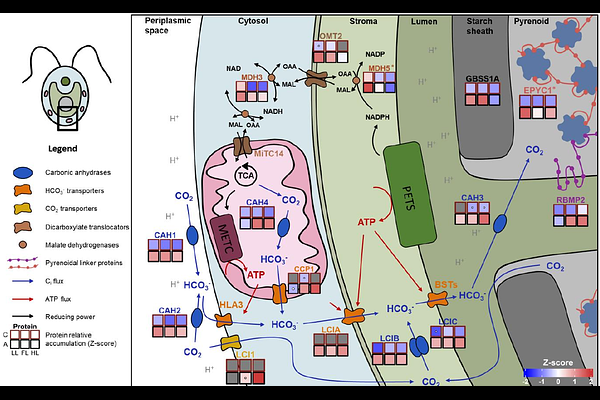Energy trade-offs under fluctuating light govern bioenergetics and growth in Chlamydomonas reinhardtii

Energy trade-offs under fluctuating light govern bioenergetics and growth in Chlamydomonas reinhardtii
Pfleger, A.; Arc, E.; Zhang, S.; Chaturvedi, P.; Antoine, E.; Gnaiger, E.; Ghatak, A.; Afjehi-Sadat, L.; Weckwerth, W.; Kranner, I.; Roach, T.
AbstractRapidly changing light intensity is a natural challenge that photosynthetic organisms can tolerate. Regulatory mechanisms of light harvesting and alternative electron pathways are critical in dissipating and distributing energy under fluctuating light intensities (FL), but less is known about downstream metabolic regulations. Here, we compared the cellular responses of Chlamydomonas reinhardtii grown under FL to cells acclimated to constant high (HL) or low light (LL), either under high (2 %) or low (0.04 %) CO2. Under low CO2, the physiology of FL cells resembled HL cells and proteomics revealed an induction of the ATP consuming carbon-concentrating mechanism, and photorespiration particularly under FL. High CO2 promoted growth under FL, albeit by a lesser extent than under HL and led to higher ATP contents than under low CO2. To fuel ATP production under low CO2, cells upregulated mitochondrial respiration under FL, while enhanced cyclic electron flow and redox shuttling between intracellular compartments was most evident under FL and LL. Chloroplastic carbon metabolism rapidly responded to light changes, independent of CO2 availability, whereas metabolites associated with mitochondrial bioenergetics responded slower, and remained abundant under high CO2. The accumulation of enzymes involved in starch synthesis and breakdown under FL, together with the transient accumulation of hexoses and hexose phosphates, indicated that cells relied on sugars as a transient carbon pool to meet changing metabolic demands under FL. We conclude that the interplay between light intensity and CO2 availability drives critical energy trade-offs, balancing photoprotection, repair, and carbon allocation, that regulate growth under FL.